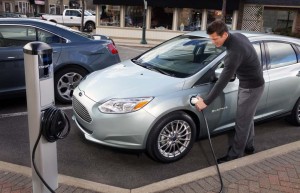
The 2017 Ford Focus EV will have a range of 100 miles, which is about 100 miles less than its competition.
As most of EV makers are following the go big or go home path when it comes to battery range, Ford is staying the course – or distance – when it comes to the next-generation Ford Focus EV: it will go about 100 miles before needing a charge.
Why? Money.
The rationale was made apparent as Kevin Layden, Ford’s director for electrification, told attendees at the SAE World Congress in Detroit, said the company felt that extra 100 miles wasn’t worth the extra $6,000 it would cost potential owners.
“I think right now with the launch of the Focus Electric at 100 miles, it is going to satisfy a big chunk of the population,” said Layden, according to Automotive News. “It’s going to be really affordable and a step up from where we are now.”
(To see more about Ford’s $4.5 billion plan for electrified products, Click Here.)
The Dearborn, Michigan-based maker’s 2017 model, which debuts later this year, jumps from the 76 miles the 2016 model got to the 100-mile mark. Both numbers are well below competitors like the Chevy Bolt and Tesla Model 3 that are expected to go twice as far – 200 miles – before charging.
Ford is going to find out in a hurry whether this gamble will pay off as the Chevy Bolt will hit showrooms this fall at 200 miles and somewhere around $30,000, if you include federal tax credits. The aforementioned Tesla Model 3 compact sedan will be able to drive 215 miles on a charge, according to officials and will come in around the same price point. Nissan plans to launch a redesigned Leaf in 2018 with a 200-mile range.
In December, Ford committed $4.5 billion to rejuvenate its electrified vehicle lineup. One of the big changes it made was cutting the price of the Focus EV by $6,000 to just under $30k so that once the government incentives were factored in it was just over $23,000.
The impact was minimal as Ford sold just 1,717 Focus EVs last year, down 21% from a year earlier. Through March, Ford sold 257 Focus EVs. The move, or lack thereof, comes after Ford committed to developing 13 new vehicles with electric powertrains by 2020 as part of $4.5 billion. That money also includes new hybrids and plug-in hybrids.
(Click Here for details about how the rise in lithium prices could stymie the market for EVs.)
“As part of this effort, we will be driving down costs of batteries, inverters and other EV components,” Layden said. “We’ll develop the next generation of the Powersplit front-wheel-drive transmission and rear-wheel-drive applications previously announced.”
The powersplit front-wheel-drive transmission is Ford’s name for its hybrid drivetrain system. In addition, Layden said that Ford is working with its supplier partners to bring to market new battery technology and investing in R&D with the University of Michigan.
Ford’s electrification news might seem ill-timed to some observers, considering the sharp downturn in gasoline prices and the possibility of an even sharper plunge in the near future. That is one reason why demand for the maker’s current battery models has fallen by roughly 25% so far this year.
Company officials admitted they need to do a better job convincing consumers of the advantages of electric propulsion, but improvements in the technology should also enhance its appeal.
(Toyota cutting production in the wake of major Japanese quake. For more, Click Here.)
The reality is that Ford, like its competitors, may have no choice but to keep expanding its electric line-up. It has to cope not only with tougher European carbon dioxide rules and U.S. mileage standards, but also the zero-emissions vehicle mandate in California. A maker that falls short could be banned from that huge market.

some green guys will have to explain to me the extra 6000 dollars it will cost to go a extra 100 miles.